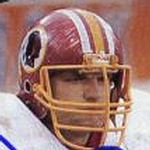Dear Doc:
I recently came across some odd looking facemasks and found out
they were manufactured by Riddell in the 1970s. What can you tell me
about older style Riddell cage type facemasks?
thanks, Scott
Dear Scott:
In the 1950s and 1960s Riddell only sold cage style facemasks that
were manufactured by Schutt Inc. In the 1970s for reasons known only
to Riddell management they decided to compete with Schutt Mfg. and
produce and market their own line of cage style facemasks.
Riddell's attempt to "corner" the facemask market would make for an
interesting Harvard Business School case study.
More than 30 years later and after countless unsuccessful new
design introductions by Riddell the facemask market has remained a
virtual monopoly for Schutt. It has long been rumored that the local
construction industry near Riddell headquarters in Chicago has enjoyed
a cost savings windfall over the last thirty years by
eliminating steel rebar that is used for building foundations and
substituting unsold scrapped Riddell facemasks which are free for the
taking at area dumpsites.
In addition to their facemask failures Riddell has also lost a
significant portion of their core helmet business to
Schutt who purchased Bike Product's helmet division in the late
1980s. Partly motivated by revenge for Riddell's original attempt
to put them out of business Schutt has subsequently made some savvy
business decisions and grown from a small family owned facemask
manufacturer into Schutt Sports a major player in the sporting goods
industry.
Let's give Riddell some credit -- it only took them 25 years to
realize that their numerous launches of radically styled facemasks
could never compete with the Schutt facemask designs. In the 1990s
Riddell changed tactics and virtually copied the Schutt facemask
designs. In addition they included, at no additional charge, one of
these Schutt style "knockoffs" with each Riddell helmet sold. How
could they not succeed now? Well, some things are just not meant to
be. As of the date of this column equipment managers across the
country continue to remove their "free" Riddell facemasks from their
newly purchased Riddell helmets and replace them with the Schutt
variety.
There is however a bit of good news that has surfaced for Riddell
as a direct result of their determination to remain in the facemask
business. Politicians from numerous states have made lucrative offers
to Riddell to get them to relocate their facemask production
facilities to their respective states in the hopes that it will
benefit their own local construction industry as it has in
Chicago over the years.
Here are some of the more interesting examples of the "creative"
efforts that have been made by the Riddell facemask designers since
the early 1970s:
(a) One of Riddell's first cage style models often referred to as
their "lacrosse" inspired line. Sales never took off but this product
line enjoyed a major comeback a few years ago when eight masks were
purchased for the movie "Rudy." What is real scary is that Riddell's
current line of facemasks that have been designed exclusively for
their ultra modern "Revolution" helmet are eerily similar to this
original design. A little advice -- please burn the original
blueprints before they fall into the wrong hands again -- future
Riddell facemask designers.
(b) Why stop at copying just Schutt facemasks? This mid 1970s
Riddell design looks like a distant relative of the lightweight
aluminum Dungard cage facemask. The only problem is that Riddell
forgot to use the aluminum and instead substituted the more
conventional and significantly heavier regular steel bar. Randy
Gradishar (Broncos) wore this style mask for several years. In our
opinion this was one of the few cage facemasks designed by Riddell
that was actually cool.
(c) This 1977 design actually realized some success. The mask was
extra strong because it was made from stainless steel. Several
outstanding players including John Jefferson (Chargers), Ken Stabler
(Oilers), and Lester Hayes (Raiders) and James Lofton (Packers) wore
this mask. This was a relatively expensive mask to produce because of
the costlier stainless steel bar and Riddell had trouble competing
against the less pricey regular steel Schutt facemasks.
(d) This design was produced in the early 1980s and was
contractually promoted through an endorsement contract with a newly
formed spring football league known as the USFL. Both products, the
facemask and the USFL, suffered the same fate and became extinct
within two years. Unlike the defunct football league, Riddell
actually saved millions of dollars in legal fees by not having
anyone to sue for their unsuccessful product.
(e) This early 1990s design actually had potential. This super
strong but lightweight plastic facemask could actually support the
weight of an automobile without breaking. Unfortunately the
protective bars were too wide and a players vision was severely
restricted by this design. After the substantial initial tooling
cost was incurred the actual unit manufacturing cost to produce this
plastic injection molded mask was quite low and Riddell produced
hundreds of thousands of these masks with hopeful, but somewhat
blinded (pardon the pun), sales expectations. If building codes for
building foundations are ever changed to approve plastic rebar then
perhaps these facemasks may also be useful. In the meantime they can
be strung together and used as an effective low cost privacy
curtain.
